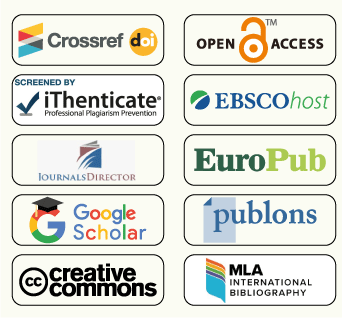Power and counterpower in Naguib Mahfouz’s Khufu’s wisdom (1939) and Sons of our alley (1959): a new historicist study
Abstract
Notions could be warriors in a battle, totally ready to fight against other notions, without shedding the blood of their utterers. Naguib Mahfouz’s two allegory-based novels Khufu’s Wisdom (1939) and Sons of Our Alley (1959) were banned when they were first published. The reason was that they symbolize some religious figures and that was interpreted as religious abuse. Accordingly, Mahfouz became a subject of an issued fatwa of death sentence that led to an unsuccessful assault in 1994. This paper attempts to prove that Mahfouz’s main target behind using religious symbols was to criticize and attack some political figures. Mahfouz’ aspirations of a classless society, a democratic system, freedom of speech and acceptance of diversity did not come true after the revolutions of 1919 and 1952. This paper tries to analyse the two novels neither through the allegorical nor the religious level, but through Greenblatt’s New Historicism and Foucault’s theory of Power. The two narratives display myriad types of counterpower that are able to challenge and defy coercion and oppression. The paper aims to find an answer to which extent the oppressed can stand out against the single power wielding and defeat the oppressors’ invincible coercion.
Keywords
Full Text:
PDFReferences
Al Naqqash, Ragaa. Pages from Naguib Mahfouz’s Diary, Al Shorouq, 2011.
Boogie, Mohamed Bakr. “The Historical Novels of Naguib Mahfouz: An Aesthetic Analysis”. Al Azhar University Magazine, Gaza, 2009. http://www.alazhar.edu.ps/arabic/Deanships/Higher_Edu/Higher_Education.htm.
Danaher, Geoff, Tony Schirato and Jen Webb. Understanding Foucault. Allen & Unwin, 2000.
El-Enany, Rasheed. The Pursuit of Meaning. Taylor & Francis e-Library, 2005.
Foucault, Michel. The History of Sexuality: An Introduction. Trans. by Robert Hurley, Pantheon Books: New York, 1978.
Foucault, Michael. Society Must Be Defended: Lectures at the College De France. Translated by David Macey, Picador, 2003.
Frum, David. “Children of the Alley: A Novel by Naguib Mahfouz”. Frum Forum https://davidfrum.com/article/children-of-the-alley. Accessed 19 August 2021.
Gomaa, Mostafa Attia. “The Narrative Vision and Intellectual Conviction of Mahfouz’s Experience” Fikr Magazine 31/1/2020.
Gould, Rebecca. “Allegory and the Critique of Sovereignty: Ismail Kadare’s Political Theologies.” Studies in the Novel, 4 (32) Johns Hopkins University Press, 2012: pp. 208–30,
https://www.jstor.org/stable/23406598. Accessed 17 Aug. 2021.
Hezam, Abdulralman. “Children of the Alley: Mahfouz's Allegory of Violence and Oppression”, Arab World English Journal (AWEJ) Special Issue on Literature No.3 October, 2015.
Lindsey, Ursula. “The World of the Alley: Naguib Mahfouz’s Cairo” The Nation, October 25, 2018. www.thenation.com/article/archive/naguib-mahfouz-world. Accessed 12 August 2021.
Lockman, Zachary. “British Policy toward Egyptian Labor Activism, 1882-1936.” International Journal of Middle East Studies, 20 (3) Cambridge University Press, 1988: pp. 265–85, http://www.jstor.org/stable/163233. Accessed 23 Aug. 2021.
Mahfouz, Naguib. Children of Gebelaawi. Trans. by Philip Stewart, Passeggiata Press Pueblo, Colorado, 1997.
Mahfouz, Naguib. Three Novels of Ancient Egypt: Khufu’s Wisdom. Trans. by Raymond Stock, Everyman’s Library, London, 2003.
Shoeir, Muhammad. The Biography of the Forbidden Novel. Dar Al Ain Publication, 2018.
Tawfiq, Wael. “I used to be a Nasserist: Naguib Mahfouz’s Confessions about the July Revolution”. Aldostor Magazine.10 October, 2020. https://www.dostor.org/3224109
Theroux, Peter. “Children of the Alley: A Translator’s Tale.” The Massachusetts Review, 42 (4), 2001: pp. 666–71, http://www.jstor.org/stable/25091810. Accessed 9 Apr. 2022.
DOI: http://dx.doi.org/10.21622/ilcc.2022.02.1.069
Refbacks
- There are currently no refbacks.
Copyright (c) 2024 Shaimaa M. Aly Asseyoufy, Rania Samir Youssef

This work is licensed under a Creative Commons Attribution-NonCommercial 4.0 International License.
Insights into Language, Culture and Communication
E-ISSN: 2812-491X
P-ISSN: 2812-4901
Published by:
Academy Publishing Center (APC)
Arab Academy for Science, Technology and Maritime Transport (AASTMT)
Alexandria, Egypt
ilcc@aast.edu

